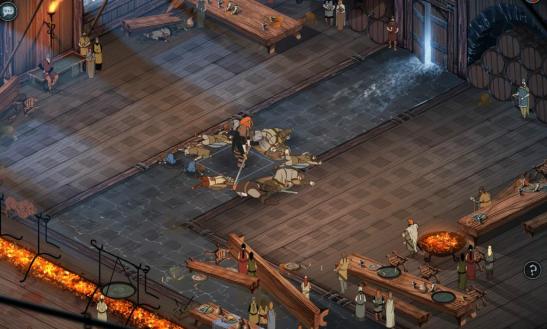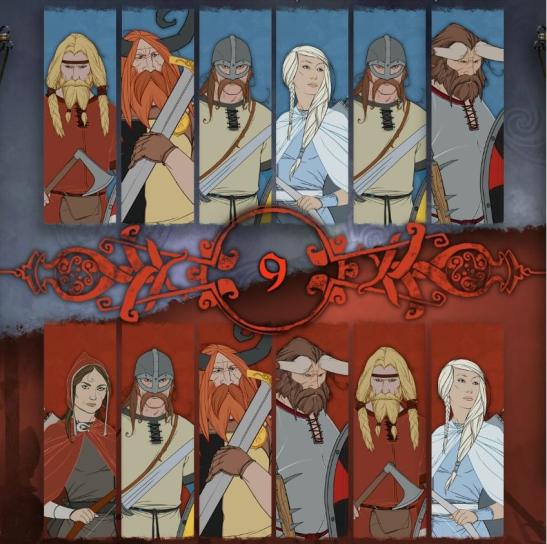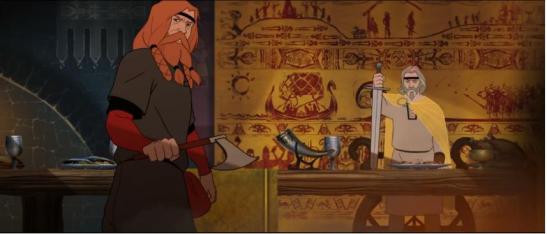Review: The Banner Saga: Factions
The Turn-based Strategy RPG is an old genre. Tempered and wrought by time, TBSes can be said to have been already perfected. The basic elements are few and simple: take a grid and press it flush against terrain. Huddle your squires and spellwrights on one corner of the map. Introduce strategic terms like turn order and height advantage and combine them with RPG mechanics. TBSes are a solid kind of game that appeal to a solid kind of mind. No twitch reflexes required. No need to memorize button combinations. All you need is the ability to manipulate outcomes and seize opportunities. What is required of you is to expand your intuition to encompass the entire battlefield, where the proudest can fall and weakest dare to ascend.
It’s no surprise that the turn-based SRPG features droves of titles under its belt. With the formula so easy to replicate, game designers need to tweak and tinker with the system to stand out from the throng. Flashy battle systems like rule restrictions, terrain penalties, and combination attacks all influence the game experience in a variety of ways. Other games see this challenge as a way to prioritize style (visual design and story) over substance (balance and gameplay). This is not automatically a bad thing. Final Fantasy Tactics was riddled with gamebreaking exploits, but a lot of people still agree that it’s one of the gold standards of SPRGs.
These kinds of games come and go, but every once in a while, an outlier will rise from the rabble. As if fulfilling an unwritten prophecy, this chosen one will come to define the genre for several years. In the early 90s, it was Fire Emblem. In the late 90s, it was stately Final Fantasy Tactics. The 2000s saw the wildly self-aware Disgaea series dress up the genre in wacky threads. This 2013, a new challenger has entered the fray with the thrumming of distant drums. Emerging from the swirling blizzard comes The Banner Saga: Factions.
The Banner Saga: Factions is an early, online multiplayer offering of Stoic Studio’s The Banner Saga. While the singleplayer game is still taking its sweet time in development limbo, Stoic Studio released TBS:F both to appease their Kickstarter backers until the game’s actual release later this year and to drum up further interest among the Steam regulars. TBS:F is then considered as tribute and advance guard—a shining spectacle of a product and a sneaky playtest. As a combat-only multiplayer experience, its time on the proving ground will stress-test its every facet. Despite the weight of its laurels, TBS:F seems to make good on a lot of its promises. It’s a worthy taste of what’s in store—something incredible, addictive, and maddeningly beautiful.
Shock and Awe
Look at him. Look at his beard. If you’re anything like me, you’re fighting against the compunction to touch that beard. If you’re nothing like me, then you are a child who knows nothing of the world. Upon starting The Banner Saga: Factions, Stoic Studio wastes no time in showing their work. With a cavalcade of giant men coming to the rescue of an exasperated jarl by cutting a swathe through a squad of his usurpers, The Banner Saga: Factions begins. Boasting of an art style inspired by the illustrious Evyvid Earle of The Sleeping Beauty fame, TBS:F paints a world where brows are perpetually, impeccably furrowed and each facial follicle evokes visual Lisztomania. Look back at that crackling virility hedge. Now imagine that subtly animated, a breeze rustling through the hair and nostrils flaring ever so slightly. Attempt to regain consciousness.
To say the art direction of TBS:F is striking is an understatement. Try something else. Try breathtaking. Dynamic. Throw out epic in there. It’s okay. It’s appropriate. You’re good for it. Stoic Studio infused each of the character units with so much personality that even their idle animations help construct the narrative canopy of their world. Archers do regular double-takes, wary that their perch might be compromised. Shieldbangers beat their weapons against their tower shields, daring the world to break through their line. The characters’ bravura is impressive, as are the throes of their death. The giants fall like warrior-kings, attempting to prop themselves up with their weapons before succumbing to their wounds. Backbiters whirl as they fall, willing themselves to die with their faces to Valhalla. Environments, while mostly static, thrive with life. Scroll over to the sides of the screen and you’ll see natives going about their normal lives, apathetic to the murderous rough-housing going on a few yards away. Bystanders ring around the battlefield, possibly lazily commenting on the proceedings while chugging their mead and chowing down on mutton. The jarl is bored rigid, his cheek in his hand. A guard is napping by the longboat’s shields. A pair of scrimshaws is gutting a narwhal to the side.
Since it’s still in the early stages, TBS:F’s music is spare but functional, meshing effectively with the robust gameplay. The music is reactive, scripted to seamlessly flow from one score to the next, tailored to the current gameplay situation. Your turn’s time limit dials down by way of a rapidly quickening drumbeat. Do you only have one team member left, defending him/herself from an axe-wielding cabal of Viking warriors? The music turns into a battle-spurred rhythm, foreboding either crushing defeat or glorious victory.
Stoic Studio promised a “mature, story-driven, turn-based strategy game steeped in Viking culture. [emphasis mine]” If The Banner Saga: Factions is a microcosmic representative of that promise, then it succeeded resoundingly. Although most ofTBS:F’s narrative is told via visuals and gameplay, what little writing it does have manages to further enrich the story’s scope and detail. The game doesn’t take the easy route by just doling out didactic unit descriptions, no. Instead, every unit features flavor text that extols their heroism and infamy. It was when I read the description of the Raider, one of the most basic units in the game, that I absolutely knew I was dealing with something outstanding:
“Stop crying. You’ll have to make the decision soon, boy. Become a farmer or fisher; hard, tedious labor for certain, but you’ll never go hungry. Become a trader, maybe live in wealth when you finally become a great liar. Become a builder or a smith, and make things that will bring others glory. Or carry this axe in your hand, and this shield in the other, and take what those lesser men have made for you.”
-A father to his son, overheard
Mutual Assured Destruction
Like any systematic game genre, TBSes live or die by their gameplay. Introduce a broken mechanic or shoddy balancing and a multiplayer SRPG will homogenize its players’ strategies until the game experience becomes nothing more than a repetitive slog. In TBS:F, they address this issue by structuring its combat philosophy around deviously simple and realistic core mechanics. Each combatant has a Strength stat which functions both as attack power and health counter. The lower your health, the less effective your attacks will be. Fatal wounds will gimp you until you’re basically just tickling Northeners’ mustaches with your giant axe. To mitigate damage done to your fleshy bits, each character also has an Armor stat. The more Armor you have, the less damage you’ll take. Literally every unit in the game can target either of the two components, leading to some very interesting mental exercises. Maim a unit now to reduce its overall effectiveness? Or should you whittle at its armor so it can be defeated with little difficulty later? From just two mechanics, players can generate a panoply of mind games.
Opposing units move after each other, eliminating the concept of initiative from the metagame. Like a game of chess played in the blistering tundra, a skirmish in The Banner Saga: Factions is won and lost by the forethought of the battling players. The turn order prominently marquees in the bottom section of the user interface, giving players a constant stream of tactical information. The player has literally everything s/he needs to think of their next moves. Mistakes unwittingly made hit hard, but premeditated battle decisions gone awry carry a heavier, more personal shame. The game punishes you for not thinking too far ahead. Leave your archers exposed and backbiters will blitz through a hole in your line to incapacitate them. Let your shieldbanger wander too far from your blitzkrieg and he will be sliced into so many Scandinavian flesh ribbons. Likewise, successfully calculated gambits lend you an immense burst of pride. Playing the slow game of carving chunks out of a combatant’s armor can pay off in dividends in the last few minutes. Spending extra Willpower to run through an obvious meatshield, in order to menace your opponent’s archers will dramatically decrease his/her effectiveness. In TBS:F, victories feel real and defeats feel deserved.
Balance of Terror
The balanced gameplay is largely tethered to Stoic Studio’s genius levelling-matchmaking system. Upon every enemy unit killed, your characters gain a trickle of Renown. Renown works as experience and currency in the world of TBS:F. It can be used to purchase palette swaps, join tournaments, or to bring more warriors into your fold. Characters also draw from it to level up or get “promoted” to become better, more specialized units. More renown is always good. If you have the dosh, you can purchase an automatic bonus that will add to your renown after every battle. Hang on. Before you decry the game as another one of those satanic “pay-to-win” multiplayer games, calm down. Promotion is easy to achieve, sure. But deciding to promote? That’s the part that’s tricky.
TBS:F’s matchmaking formula takes a player’s two statistics into account: Elo rating and Team Power. The Elo rating is essentially the relative skill level of the players, determined largely by their win-loss ratio. Team Power is the overall strength of your assembled Viking pillager posse. It works like this: the formula will deign to match your Team Power with opponents of the same level. Then it will factor in your Elo rating and choose the best match from that pool of players. More promoted units mean a tougher fight. Of course, if you’ve battled and parleyed with your giants and wildmen for as long as it took to promote them, you’ll still perform decently. However, if you shelled out the skrilla hoping for a straight shot to the top, a grizzled general of a player will fillet your ass and lovingly hand it back to you. Oh man. Oh lord. Let me just say, that on the semi-rare instance that this happens, committing tribal genocide on these would-be wallet warriors is incomparably gratifying. As of writing this, ten years have been knocked off my age. Crow’s feet have disappeared to be replaced by cosmetically-positioned battle scars. My singular chest hair has curled into a fist.
It’s not without its flaws, but the game tries its best to keep the scales level. If the game can’t find a suitable match for your rating, it could pair you up with someone of a marginally higher/lower rank; however, you will enjoy either reduced renown or an underdog bonus depending on how wide the skill disparity is between your opponent and you. A wider gaming audience will help moderate the frequency of this occurrence, and it’s a good thing that TBS:F’s overwhelming positives are making it enjoy a growing following.
The Banner Saga: Factions is a surprisingly accessible game with considerable tactical depth. For Stoic Studio to produce a competitive SPRG that is enthralling to behold, while still addressing major balance issues, should be commended. Despite being an early build, TBS:F features a staggeringly wide variety of teambuilding options and combat strategies. With Stoic’s promise of continual support for the multiplayer game even while the single-player game is still in development, things can only go up from here. Though I did not help Kickstart Stoic’s Nordic brainchild, this game has convinced me to definitely buy The Banner Saga when it gets released. But, you there, consider playing this game. Go on. Get on Steam and download it. It’s free. It’s simple. All you need is a keen blade and a keener mind. So sharpen your sword, oil your leathers, and gird your loins. We charge at the first horn.










What an amazing article! Thanks a ton for taking the time to check it out and very glad your having fun with it. We’ve got more on the way. 🙂
Oh man, is that you, Arnie Jorgensen? Oh wow. GREAT GAME, BTW. But you probably already know that by what I’ve written up there. Thank you for this glimpse into a great future product. And thanks for making it free. Never would’ve gotten to play it without that ballsy business decision.
What an incredibly well written review. I had the chance to kickstart this game and from the 1st second I started the game I was totally captured. Your review couldn’t have captured all the things I wish I could tell people about The Banner Saga/Factions and also of Stoic. Hear hear!
Huzzah! Thank you for your words. I wish I was onboard the Kickstarted steamboat before it sailed, but I suppose I could just purchase the game when it gets released. And thank you for lending a positive voice. With how the Internet is decrying this F2P release, those who actually enjoy the game are getting boxed out.